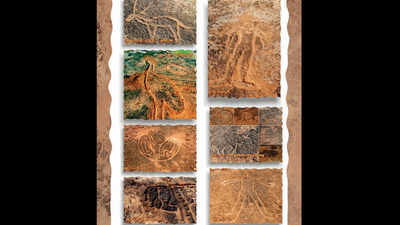Trending
This story is from July 21, 2019
Maharashtra may let corporates nurture Konkan petroglyphs
Archaeologists don’t usually set out to the flat hilltops of Konkan for a treasure hunt as throwing up historical gems isn’t considered the coastal region’s strongest suit. But it was on its vast swathes of red, clayey barrenness that the state

A booklet shows some of the tourism-promising petroglyphs of Konkan that include depictions of animals and human figures
Archaeologists don’t usually set out to the flat hilltops of Konkan for a treasure hunt as throwing up historical gems isn’t considered the coastal region’s strongest suit. But it was on its vast swathes of red, clayey barrenness that the state, along with a bunch of avid naturalists, recently found a set of exciting ancient rock carvings or petroglyphs as they are called, that formed the focus of a talk at the Asiatic Society on Friday.
In this session, Tejas Garge, director of the state's department of archaeology and museums, transported the audience to Ratnagiri, Rajapur and other bits of Konkan where, back in 2012, three avid naturalists—Sudhir Risbud, Dhananjay Marathe and Surendra Prabhudesai—stumbled upon these mysterious depictions of wild animals, human figures and abstract patterns.The fact that many of these had been etched into the exposed stone of horizontal surfaces set the imprints curiously apart from the autographs left by Stone Age peoples internationally that are drawn on walls or standing rocks. When the naturalists alerted Garge to the discovery, the state department of archaeology and museums joined in the search in 2017 and soon, a two year investigation yielded over 1200 petroglyphs in 56 villages in Konkan.
The bounty comprised depictions of wild animals including pythons, leopards and wild boars, birds such as the peacock and aquatic creatures such as sharks and stingrays—all of which Garge reckons date back to be between 10,000 BC and 2,000 BC. The fact that the bull was missing conspicuously from all of these depictions led Garge to deduce that the petroglyphs probably belong to the prehistoric age. “The bull was a figure of prominence for those involved in agriculture,” said Garge, who also found the horse to be prominently absent from these depictions that covered the gamut from sea turtle to a bird known as “elephant bird” that's not local to Konkan.
Unfotunately, the prehistoric artists were not aware of the future of their clayey canvas which, in government records, shows up as vast patches of “barren land” and are under threat from laterite mining. Conservation of these archeologically significant carvings is a concern as they fall on privately owned areas and it would be costly for the state to buy all of it, stated Garge. To ensure protection, he said the state was mulling something on the lines of the Centre’s ‘Adopt-a-monument’ strategy that lets corporates nurture historical monuments. “We will let the respective owners charge entry tickets to the site as a form of earning which they can use for conservation,” said Garge.
In this session, Tejas Garge, director of the state's department of archaeology and museums, transported the audience to Ratnagiri, Rajapur and other bits of Konkan where, back in 2012, three avid naturalists—Sudhir Risbud, Dhananjay Marathe and Surendra Prabhudesai—stumbled upon these mysterious depictions of wild animals, human figures and abstract patterns.The fact that many of these had been etched into the exposed stone of horizontal surfaces set the imprints curiously apart from the autographs left by Stone Age peoples internationally that are drawn on walls or standing rocks. When the naturalists alerted Garge to the discovery, the state department of archaeology and museums joined in the search in 2017 and soon, a two year investigation yielded over 1200 petroglyphs in 56 villages in Konkan.
The bounty comprised depictions of wild animals including pythons, leopards and wild boars, birds such as the peacock and aquatic creatures such as sharks and stingrays—all of which Garge reckons date back to be between 10,000 BC and 2,000 BC. The fact that the bull was missing conspicuously from all of these depictions led Garge to deduce that the petroglyphs probably belong to the prehistoric age. “The bull was a figure of prominence for those involved in agriculture,” said Garge, who also found the horse to be prominently absent from these depictions that covered the gamut from sea turtle to a bird known as “elephant bird” that's not local to Konkan.
Unfotunately, the prehistoric artists were not aware of the future of their clayey canvas which, in government records, shows up as vast patches of “barren land” and are under threat from laterite mining. Conservation of these archeologically significant carvings is a concern as they fall on privately owned areas and it would be costly for the state to buy all of it, stated Garge. To ensure protection, he said the state was mulling something on the lines of the Centre’s ‘Adopt-a-monument’ strategy that lets corporates nurture historical monuments. “We will let the respective owners charge entry tickets to the site as a form of earning which they can use for conservation,” said Garge.
A key point about the fertile tourism potential buried deep within these officially barren lands came when the team set out to put up signage across the sites that had been attracting droves of tourists since the amateur archaeologists published their reports on the petroglyphs last year. At one site, Garge recalled, a tea seller dissuaded his team from putting up a signboard as that would eat into his business. “I used to make Rs 200 a week earlier,” the tea seller told them. "Now I make Rs 2000 a week because people stop by my shop, have a cup of tea and ask for directions to the carvings."
End of Article
FOLLOW US ON SOCIAL MEDIA










